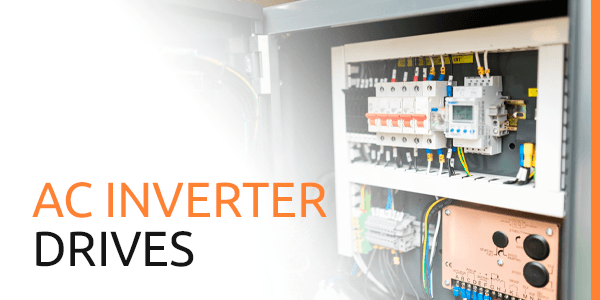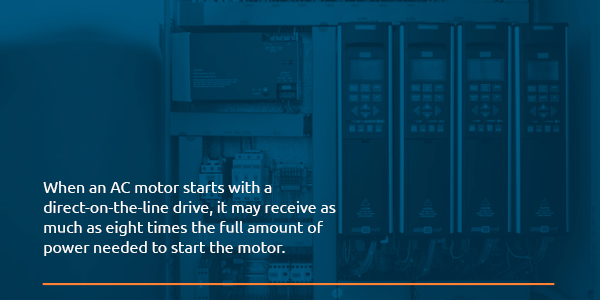AC Inverter Drives
When you need to drive power to an alternating current (AC) motor, you have a few options. Some technicians and designers may opt for a simple AC drive. These are some of the least complex drives available, but they provide less control over the motor’s speed and may make a system less energy-efficient than it could be.
Engineers and technicians can also use more advanced drives — like AC inverter drives — to regulate the amount of power delivered to the motor, both on start-up and while it runs.
This guide will cover the basics of AC inverter drives — what they are, what they aren’t, what benefits they offer and which common troubleshooting strategies to employ.
-
Schneider Electric
Schneider Inverter drive AC ATV71HU22M3
- Model #:
- ATV71HU22M312
- UPC #:
- 78590153392
- Part #:
- ATV71HU22M312
-
Schneider Electric
Schneider Inverter drive AC ATV71HU22N4383
- Model #:
- ATV71HU22N438312
- UPC #:
- 78590192600
- Part #:
- ATV71HU22N438312
-
Schneider Electric
Schneider Inverter drive AC ATV71HU22N4Z
- Model #:
- ATV71HU22N4Z12
- UPC #:
- 78590165838
- Part #:
- ATV71HU22N4Z12
-
Schneider Electric
Schneider Inverter drive AC ATV71HU22Y
- Model #:
- ATV71HU22Y12
- UPC #:
- 78590144314
- Part #:
- ATV71HU22Y12
-
Schneider Electric
Schneider Inverter drive AC ATV71HU30M3Z
- Model #:
- ATV71HU30M3Z12
- UPC #:
- 78590158409
- Part #:
- ATV71HU30M3Z12
-
Schneider Electric
Schneider Inverter drive AC ATV71HU30N4
- Model #:
- ATV71HU30N412
- UPC #:
- 78590160286
- Part #:
- ATV71HU30N412

What Are AC Inverter Drives?
AC inverter drives — also known as variable-frequency drives (VFDs), inverters, AC drives and microdrives, among other names — are motor drives used in drive systems to control the speed and torque of an AC motor by varying the frequency and voltage delivered to the motor.
In an AC motor system with an inverter drive, an AC current is delivered to the drive. The drive then regulates that current, converting the power from AC to DC, which allows it to control both the voltage and frequency of the output current.
AC inverter drives have three main components — an input converter, a filter and an output inverter:
- Converter: The converter — or rectifier — changes the received AC current into a DC current. Converting it to DC allows the drive to adjust the voltage delivered to the engine.
- Filter: The DC filter provides voltage smoothing and filters out noise and potentially damaging high-frequency currents.
- Inverter: The inverter, in the form of insulated-gate bipolar transistors (IGBTs), changes the DC current that has passed through the bus filter back into an AC current. Converting here allows the drive to adjust the frequency of the current delivered to the engine.
Together, these three components allow the drive to take the AC current and transform it into a variable-frequency AC output. This process effectively enables the drive to deliver power based on the desired motor output — with variable frequency and voltage — reducing inrush current and overall energy consumption.
Typically, the AC motor that the AC drive powers is a three-phase induction motor, and the inverter drives are configured to power three-phase motors as a result. In some drive systems, the motor may be a single-phase induction or synchronous model. However, the advantages that three-phase motors offer — simple construction, lack of brushes and a self-starting torque — make them the more popular option. Most inverter drives are also compatible with three-phase motors as a result.
The Difference Between ECM Drives, VFDs and Inverters
Electronically commutated motor (ECM) drives, VFDs and inverters are sometimes used interchangeably to describe drives that deliver variable power to motors. These terms are conflated with each other due to overlaps in naming conventions and functionalities. However, the three are fully distinct components that will only work in certain systems and circumstances.
ECM drives provide variable voltage and frequency to a three-phase induction motor, like a VFD. Unlike VFDs, this motor is a DC model. The ECM drive’s output current is DC to match and is also electronically different compared to an AC drive — such as a VFD.
An inverter alone, on the other hand, will only convert a current from DC to AC. Depending on the context, however, the term “inverter” may also refer to a VFD or AC inverter drive. If an “inverter” is delivering varying power to a motor as part of a drive system, it’s likely an AC inverter drive.

Uses and Benefits of AC Inverter Drives
The most significant advantages that AC inverter drives provide is extending the life span of drive system components and reducing energy usage.
When an AC motor starts with a direct-on-the-line drive, it may receive as much as eight times the full amount of power needed to start the motor. An AC inverter drive can also start an AC motor at zero voltage and gradually bring the motor up to speed. Limiting inrush current helps provide a gentler start-up. This lower starting voltage can extend motor life, reduce strain on the power distribution system and reduce overall power consumption — providing savings both on equipment repairs and total energy usage.
Because the VFD can adjust delivered voltage and frequency, it can also control a motor’s operating speed and torque. Controlled torque helps prevent the motor from burning out in case a jam or overload occurs. Variable operating speeds give the operating technician more control over how much energy the drive delivers to the motor — again, allowing them to reduce total power consumption.
Troubleshooting Common AC Inverter Drive Issues
When an AC inverter is knocked offline or fails to deliver power to the motor, it doesn’t necessarily mean the drive is dead. Often, you can resolve a problem without needing to replace the drive. If available, a good place to start is your AC inverter drive’s controller display. Electronic controllers gather data on voltage, current, operating temperatures and potential internal faults. The controller display information can be a major help when diagnosing a drive’s problem — like overheating or faulty wiring.
If this information doesn’t help you diagnose the issue, checking common problem areas — like drive wiring and connection — is a good next step.
AC drives can also sometimes cause a type of damage to motors known as electric motor fluting — evenly spaced pits on the motor bearings caused by electrical machining. It happens when shaft currents go to the ground through a motor’s bearing. Depending on the severity of the damage, the bearing may appear to have a frosted texture or visible pitting. With more extreme fluting, evenly spaced grooves may be visible.
This fluting is sometimes caused when an AC drive’s current passes from a motor’s shaft to its bearing. Insulating the shaft from the bearings can mitigate this damage. Shaft grounding can also help prevent fluting.
This problem can also be caused by improper welding that joins the motor shaft with the ground path. However, it’s worth inspecting the drive system if you notice this kind of damage on a motor with an AC inverter drive.
Contact Us Today to Buy AC Drives or Schedule Service
AC inverter drives offer cost-efficient power management for an AC drive system. If you need a new AC drive or a technician who has the expertise to repair an AC inverter drive, we can work with you. Call us today at 877-249-1701 or request a quote to get in touch.
